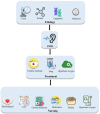Research progress on the treatment and nursing of sensorineural hearing loss
- PMID: 37346087
- PMCID: PMC10279882
- DOI: 10.3389/fnins.2023.1199946
Research progress on the treatment and nursing of sensorineural hearing loss
Abstract
This article provides a comprehensive review of the progress in the treatment and care of sensorineural hearing loss (SNHL), which is a common disease in the field of otolaryngology. In recent years, the incidence of SNHL has been on the rise due to factors such as fast-paced lifestyles, work pressure, and environmental noise pollution, which have a significant impact on the quality of life of patients. Therefore, the study of the treatment and care of SNHL remains a hot topic in the medical community. Despite significant advances in this field, there are still some challenges and limitations. For example, there is currently no single method that can completely cure SNHL, and the effectiveness of treatment may vary significantly among individuals. In addition, due to the complex etiology of SNHL, the prognosis of patients may vary greatly, requiring the development of personalized treatment plans and care strategies. To address these challenges, continuous research is needed to explore new treatment methods and care models to improve the quality of life of patients. In addition, there is a need for health education programs for the general public to raise awareness of SNHL and promote preventive measures to reduce its incidence. The ultimate goal is to ensure the sustainable development of the field of SNHL treatment and care, thus ensuring the health and well-being of affected individuals.
Keywords: nursing; progress; review; sensorineural hearing loss; treatment.
Copyright © 2023 Liu, Han, Zhou, Huang and Huang.
Conflict of interest statement
The authors declare that the research was conducted in the absence of any commercial or financial relationships that could be construed as a potential conflict of interest.
Figures
Similar articles
-
Advancements in prevention and intervention of sensorineural hearing loss.Ther Adv Chronic Dis. 2022 Jun 27;13:20406223221104987. doi: 10.1177/20406223221104987. eCollection 2022. Ther Adv Chronic Dis. 2022. PMID: 35782345 Free PMC article. Review.
-
The future of Cochrane Neonatal.Early Hum Dev. 2020 Nov;150:105191. doi: 10.1016/j.earlhumdev.2020.105191. Epub 2020 Sep 12. Early Hum Dev. 2020. PMID: 33036834
-
Rodent models in sensorineural hearing loss research: A comprehensive review.Life Sci. 2024 Dec 1;358:123156. doi: 10.1016/j.lfs.2024.123156. Epub 2024 Oct 21. Life Sci. 2024. PMID: 39442868 Review.
-
Quality of Life in Children with Sensorineural Hearing Loss.Otolaryngol Head Neck Surg. 2020 Jan;162(1):129-136. doi: 10.1177/0194599819886122. Epub 2019 Nov 5. Otolaryngol Head Neck Surg. 2020. PMID: 31684823
-
Lassa fever-induced sensorineural hearing loss: A neglected public health and social burden.PLoS Negl Trop Dis. 2018 Feb 22;12(2):e0006187. doi: 10.1371/journal.pntd.0006187. eCollection 2018 Feb. PLoS Negl Trop Dis. 2018. PMID: 29470486 Free PMC article. Review.
Cited by
-
A Consolidated Understanding of the Contribution of Redox Dysregulation in the Development of Hearing Impairment.Antioxidants (Basel). 2024 May 13;13(5):598. doi: 10.3390/antiox13050598. Antioxidants (Basel). 2024. PMID: 38790703 Free PMC article. Review.
-
Protective Effect of Mesenchymal Stem Cell-Derived Extracellular Vesicles on Inner Ear Sensorineural Cells Affected by Cisplatin.Medicina (Kaunas). 2025 Jun 5;61(6):1042. doi: 10.3390/medicina61061042. Medicina (Kaunas). 2025. PMID: 40572730 Free PMC article.
-
The Role of Platelet-Rich Plasma in the Management of Sensorineural Hearing Loss: Current Evidence and Emerging Trends.Cureus. 2024 Sep 4;16(9):e68646. doi: 10.7759/cureus.68646. eCollection 2024 Sep. Cureus. 2024. PMID: 39371823 Free PMC article. Review.
References
-
- Alkén J., Håkansson S., Ekéus C., Gustafson P., Norman M. (2019). Rates of extreme neonatal hyperbilirubinemia and kernicterus in children and adherence to National Guidelines for screening, diagnosis, and treatment in Sweden. JAMA Netw. Open 2:e190858. doi: 10.1001/jamanetworkopen.2019.0858, PMID: - DOI - PMC - PubMed
-
- Baumgartner J. E., Baumgartner L. S., Baumgartner M. E., Moore E. J., Messina S. A., Seidman M. D., et al. . (2021). Progenitor cell therapy for acquired pediatric nervous system injury: traumatic brain injury and acquired sensorineural hearing loss. Stem Cells Transl. Med. 10, 164–180. doi: 10.1002/sctm.20-0026, PMID: - DOI - PMC - PubMed
Publication types
LinkOut - more resources
Full Text Sources


